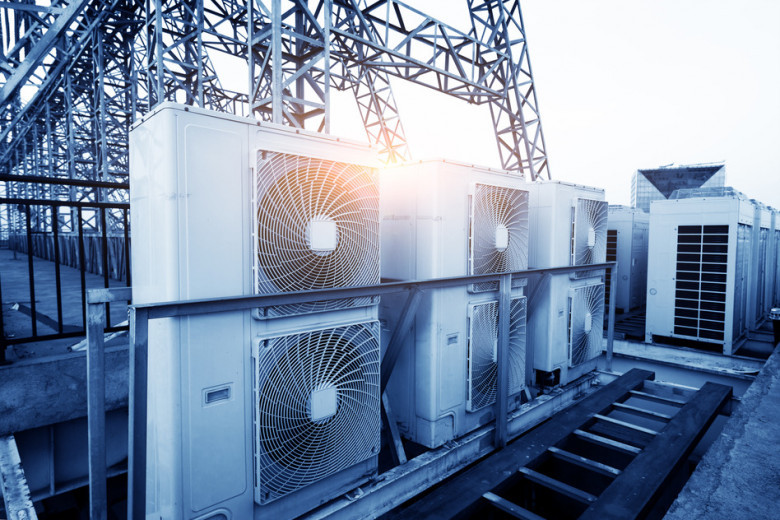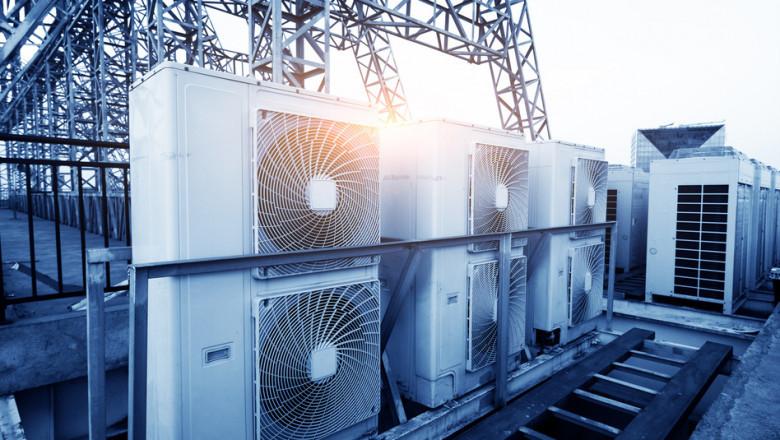views

Introduction
The Germany HVAC Systems Market is undergoing a significant transformation, driven by the country’s ambitious Energy Transition (Energiewende). Germany’s commitment to reducing its carbon footprint and increasing reliance on renewable energy sources is reshaping the way heating, ventilation, and air conditioning (HVAC) systems are designed, regulated, and used. With rising concerns about climate change and energy efficiency, the demand for low-carbon, energy-efficient HVAC solutions is growing rapidly. This shift toward sustainable energy has profound implications for the HVAC industry, as businesses and consumers seek solutions that align with Germany’s energy goals while maintaining comfort and cost-effectiveness. In this article, we’ll explore the influence of Energiewende on HVAC system designs, the emerging regulations, and the industry's response to energy-efficient technologies.
Germany’s Energy Transition (Energiewende)
An Overview Germany’s Energy Transition, known as Energiewende, is a long-term strategy aimed at reducing greenhouse gas emissions, phasing out nuclear energy, and dramatically increasing the share of renewable energy in the country’s energy mix. The Energiewende policy, which began in the early 2000s, seeks to provide a sustainable future by promoting energy efficiency, shifting toward wind and solar power, and reducing reliance on fossil fuels. By 2050, Germany aims to cut its carbon emissions by 80-95% compared to 1990 levels.
The government’s commitment to green energy is evident through the implementation of several policies, such as the Renewable Energy Sources Act (EEG), which provides financial incentives for renewable energy producers. As a result, Germany’s energy grid is becoming increasingly decentralized, with a larger share of electricity generated from solar, wind, and biomass. These changes have far-reaching consequences for industries, particularly the HVAC sector, as the demand for systems that are compatible with renewable energy sources increases.
Energy-Efficient HVAC Systems: Meeting the Demands of the Energiewende The shift to renewable energy is not only changing the sources of energy in Germany but also influencing the design and functionality of HVAC systems. Traditionally, HVAC systems have been heavily reliant on fossil fuels like natural gas and coal. However, with the government’s push for cleaner energy solutions, the market is seeing a surge in energy-efficient HVAC technologies that integrate with sustainable energy sources.
1. Heat Pumps: A Cornerstone of the Future: One of the most notable changes in the Germany HVAC systems market is the rise of heat pumps. Heat pumps are highly energy-efficient systems that can provide both heating and cooling by transferring heat from one place to another. They are especially efficient when paired with renewable energy sources like solar and wind power. Heat pumps draw energy from the environment, such as the air, ground, or water, making them a renewable alternative to traditional gas-powered heating systems.
Germany’s commitment to reducing carbon emissions has made heat pumps a key component of residential and commercial heating systems. The government’s financial incentives and rebates for energy-efficient technologies, including heat pumps, have further accelerated their adoption. Heat pumps are also seen as an ideal solution for Germany’s shift toward a smart grid, where energy generation and consumption are dynamically balanced.
2. Integration with Solar and Wind Energy: As solar and wind energy become more prevalent in Germany’s energy mix, HVAC systems are evolving to integrate seamlessly with these renewable sources. For example, HVAC systems can be powered directly by solar energy, reducing dependency on the grid and lowering overall energy consumption. Similarly, wind-powered HVAC solutions are becoming more feasible, particularly in rural areas where wind farms are common.
Smart thermostats and energy management systems are also gaining traction in the German market, as they help consumers optimize their energy usage and reduce waste. These systems are designed to adjust heating and cooling based on real-time energy availability, which can be influenced by the intermittent nature of renewable energy sources like wind and solar. By intelligently managing energy consumption, these HVAC systems align with Germany’s broader sustainability goals.
3. Geothermal Heating: Harnessing the Earth’s Energy: Geothermal energy, which utilizes the Earth’s natural heat, is also playing a significant role in the development of sustainable HVAC systems. In Germany, geothermal heating is being increasingly integrated into both residential and commercial buildings, offering a reliable, energy-efficient alternative to conventional heating systems. Geothermal heat pumps are particularly effective in colder climates, where they can provide heating and hot water throughout the year.
The adoption of geothermal HVAC systems is closely tied to the growing availability of incentives and government support for renewable energy projects. By utilizing geothermal energy, buildings can drastically reduce their reliance on fossil fuels and lower their carbon emissions.
Regulatory Changes: How Germany is Shaping the HVAC Market As part of the Energy Transition, Germany has implemented several regulations that directly impact the HVAC systems market. These regulations aim to reduce energy consumption, promote sustainability, and encourage the adoption of renewable energy technologies.
1. Energy Efficiency Standards and Labeling: Germany has stringent energy efficiency standards for HVAC systems, ensuring that new installations comply with strict requirements to minimize energy consumption. These standards are aligned with the European Union’s energy efficiency directives, which mandate energy labeling for appliances and HVAC equipment. The energy labels, which range from A+++ (most efficient) to G (least efficient), help consumers make informed decisions when purchasing HVAC systems.
The energy efficiency standards also apply to existing buildings undergoing renovation or retrofitting. As part of the German Energy Saving Ordinance (EnEV), building owners must ensure that their HVAC systems meet certain energy performance criteria. These regulations have spurred the market for high-efficiency HVAC products, such as variable refrigerant flow (VRF) systems, which offer greater energy savings compared to traditional HVAC systems.
2. Carbon Pricing and Emission Reduction Policies: The German government has introduced carbon pricing mechanisms to incentivize industries to reduce their carbon emissions. Under the European Union Emissions Trading System (EU ETS), companies that emit greenhouse gases must purchase carbon credits to offset their emissions. This policy creates a financial incentive for businesses to adopt low-carbon technologies, such as energy-efficient HVAC systems that minimize their environmental impact.
In addition to carbon pricing, Germany has introduced various tax breaks and subsidies for energy-efficient building upgrades, including HVAC system replacements. These policies aim to reduce the overall energy consumption of buildings, which is crucial to achieving the country’s climate goals.
3. Building Codes and Energy Performance Certificates: Germany’s building codes, particularly the Energy Conservation Ordinance (EnEV), mandate that all new buildings meet high standards of energy efficiency. This has led to the widespread adoption of energy-efficient HVAC systems in both residential and commercial properties. Energy performance certificates (EPCs) are required for all buildings, which provide a clear indication of the energy efficiency of the HVAC system and the building as a whole.
In line with these regulations, many new HVAC systems in Germany are being designed to integrate with smart building technologies, such as building automation systems (BAS) and energy management systems (EMS). These systems enable building owners and managers to optimize energy consumption, reduce waste, and improve overall efficiency.
The Market Response: Demand for Low-Carbon, Energy-Efficient HVAC Solutions As a result of these regulatory changes and the push for renewable energy, the demand for low-carbon, energy-efficient HVAC systems in Germany is rising. The market is responding with innovations in technology, such as:
1. Smart HVAC Systems: Germany’s smart homes and buildings market is thriving, driven by the increasing demand for energy-efficient solutions. Smart HVAC systems, which are capable of adjusting to real-time energy availability, are becoming a common feature in both residential and commercial properties. These systems can be integrated with smart thermostats, sensors, and energy management platforms to maximize energy savings and reduce consumption.
2. Hybrid Systems: Hybrid HVAC systems that combine renewable energy sources with traditional heating methods are gaining popularity in Germany. These systems offer flexibility, allowing building owners to switch between different energy sources based on availability and cost. For example, a hybrid system might use solar energy during the day and switch to a heat pump or gas-based system during the night.
3. High-Efficiency Boilers: Gas boilers that meet high-efficiency standards are also in demand in the German HVAC market. These boilers are designed to reduce energy consumption and carbon emissions while maintaining reliable heating performance.
Conclusion
The Germany HVAC Systems Market is evolving in response to the country’s Energy Transition and the growing demand for renewable energy solutions. With a focus on energy efficiency, low-carbon technologies, and sustainable building practices, HVAC systems are becoming increasingly integrated with renewable energy sources like solar, wind, and geothermal. As the government continues to implement stringent energy efficiency regulations and incentives, the market will see continued growth in energy-efficient HVAC technologies.












![¿Cómo puedo contactar con una persona en vivo en los vuelos de Frontier? [Guía paso a paso]](https://timessquarereporter.com/upload/media/posts/2025-06/12/como-puedo-contactar-con-una-persona-en-vivo-en-los-vuelos-de-frontier-guia-paso-a-paso_1749705127-s.jpg)
![How Do I Get to a Live Person at Frontier Flights? [Step-by-Step Guide]](https://timessquarereporter.com/upload/media/posts/2025-06/12/how-do-i-get-to-a-live-person-at-frontier-flights-step-by-step-guide_1749705004-s.jpg)








Comments
0 comment